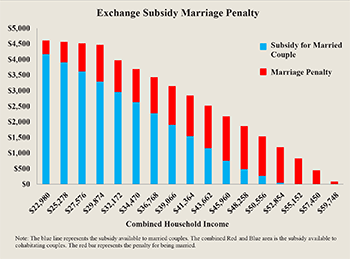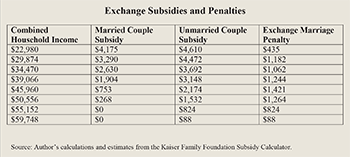The Health Exchange Marriage Penalty
No. 788
Thursday, November 07, 2013 - National Center for Policy Analysis
by Devon M. Herrick
Just as there are penalties in the tax code for couples who get married,
financial penalties in the Patient Protection and Affordable Care Act (ACA) also
discourage couples from "tying the knot." The ACA establishes state health
insurance exchanges where qualifying individuals can purchase subsidized,
individual health insurance, starting in October 2013.
However, the exchange subsidies are more generous to unmarried couples than
to couples who marry.
Who Qualifies for Health Insurance Exchange Subsidies? All
legal U.S. residents will be allowed to purchase health coverage in the
exchange. However, subsidies will only be available to individuals and families
with incomes from 100 percent to 400 percent of the federal poverty level - from
about $23,550 to more than $94,200 for a family of four. Families with incomes
below 133 percent must enroll in Medicaid if it is available, and if they
qualify to participate in their state. In addition, individuals who have access
to affordable employer coverage will not receive subsidies.
The exchange subsidies are rather generous to low-income individuals.
Qualifying individuals and families earning 100 percent of the federal poverty
level will pay no more than 2 percent of their income. The federal government
will cover the rest of their premiums. As income rises, the subsidies phase out,
but a family earning 400 percent of the poverty level will pay no more than 9.5
percent of its income in premiums.
The Federal Poverty Level (FPL) does not rise proportionally with the number
of individuals in the family. For example, the federal poverty level is $11,490
for a single individual, but only $15,510 for a family of two adults (that is,
$4,020 more for a married couple). Thus, because the federal poverty level is
not a multiple of family size, two unmarried individuals qualify for larger
combined exchange subsidies than they would if they were married.

Penalty for Getting Married. The blue bars in the figure
represent the subsidy available to married couples in each income group, while
the combined red and blue bars represent the combined subsidy available to
unmarried couples (whether they live together or independently). The red bars
show the amount of health insurance subsidy penalties couples will suffer by
getting married. The penalties are especially high for moderate-income
couples.
Consider the case of two unmarried college students each earning 200 percent
of the FPL (about $23,000 annually), who move in together. If that same couple
married, their combined household income of nearly $46,000 would rise as a
percent of the poverty level from 200 percent (individually) to 296 percent for
a married family of two. As a result, their premiums in the health insurance
exchange would be capped at a higher percentage of their income, providing a
smaller total subsidy. Instead of capping their individual premiums at 6.3
percent of income as two individuals earning twice the FPL, their premiums would
be capped at 9.4 percent of income for a family of two earning 296 percent of
poverty. For example [see the figure]:
Individually they would each qualify for a subsidy of about $1,087, or $2,174
per household.
If that same couple were to marry, their subsidy would fall to $753.

Thus, their marriage penalty is $1,421. The exchange marriage penalty is
especially pronounced for couples in moderate-income households with an income
of $30,000 to $55,000 annually. [See the table.]
Moreover, were this couple to have a child together, the Tax Policy Center
estimates they would suffer an additional penalty of $2,672 per year in higher
taxes as a result of their decision to get married (although their ObamaCare
Exchange penalty would fall by $456). It is a reasonable bet that $3,637 (the
combined marriage penalty) is a large enough annual penalty to make many young
couples living together hesitate about marriage.
More than half of marriages are preceded by the couple living together - a
living arrangement that is about 15 times more common than a half-century ago.
Indeed, nearly two-thirds of couples who live together view it as a step toward
marriage, according to the Pew Research Center. National studies show that
low-income couples are less likely to marry than higher-income couples. The
difference may be partially be due to existing marriage penalties in the tax
code.
Conclusion. The structure of the exchange subsidies creates
perverse disincentives to family formation that add to the existing marriage
penalty in the tax law. As a result of these penalties, many moderate-income
couples could decide marriage is a luxury they cannot afford.
Devon M. Herrick is a senior fellow with the National Center for Policy
Analysis.
Copyright © 2012 National Center for Policy Analysis. All rights reserved.